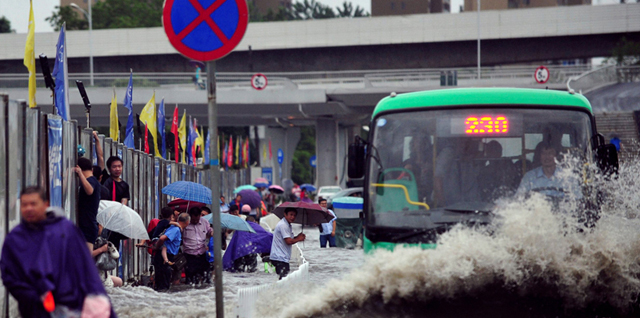
近几个月来,很多小伙伴们的微博或微信朋友圈都被南方洪涝灾情照片刷屏了:洪水淹没了大地,人们不得不淌着及膝甚至齐腰的水艰难前行。
One after another, cities in southern and central China have found themselves *inundated with heavy rainfall. But is the rain the sole factor to blame for the recent floods in more than 20 Chinese cities? Not necessarily so.
中国中部和南部多个城市遭遇强降雨。但暴雨是否就是引起20多个城市洪涝灾害的唯一原因呢?答案未必如此。
Beyond their superficial causes, the floods can be traced back to climate change. Fan Shenggang, director general of the International Food Policy Research Institute, told The New York Times: “Climate *variability is increasing the frequency and intensity of extreme weather events such as droughts and floods.”
除了这个表面原因,洪水爆发的原因还可追溯至气候变化。国际食物政策研究所所长樊胜根在接受《纽约时报》采访时表示:“气候变化增加了洪涝、干旱等极端天气出现的频率和强度。”
El Nino, a warm-weather phase that occurs every three to six years, is just one of the elements *exacerbating climate change this year. This El Nino is the strongest since records collection began in 1951, and it resembles a 1998 weather pattern that flooded the Yangtze River and killed thousands, Liu Ning, vice-minister of water resources, told Xinhua News Agency.
“厄尔尼诺”,一种平均每三至六年发生一次的天气变暖异常现象,是加剧今年气候变化的因素之一。水利部副部长刘宁接受新华社采访时表示,这次的厄尔尼诺现象是自1951年有记录以来最强烈的一次,天气状况也和1998年造成数千人死亡的长江特大洪水十分相似。
During El Nino, currents in the Pacific Ocean bring warm water to the surface and heat up the air. As a result, weather patterns across much of Asia and other regions around the Pacific have shifted.
厄尔尼诺现象发生时,太平洋的洋流将温暖的海水带到海洋表面,导致气温上升,进而导致亚洲及环太平洋地区天气状况发生变化。
These unusual weather patterns may have contributed to the high levels of flooding, but they alone are not responsible for the damage those floods are causing. Poor city planning is also worsening the situation.
反常的天气状况有可能引发特大洪水,但洪水所带来的破坏并非完全归咎于此。糟糕的城市规划让情况雪上加霜。
When there are heavy rains, lakes are supposed to absorb and slowly expel water, according to Ke Zhiqiang of the environmental advocacy group Green City of Rivers. However, in Wuhan, one of the worst-hit areas, many lakes were filled in for property development. The Beijing News reported that in the six decades after 1949, the number of lakes in Wuhan has shrunk from 127 to 38.
环保公益组织“绿色江城”负责人柯志强称,发生暴雨时,湖泊理应吸收并缓慢地排出雨水。然而在重灾区之一的武汉,许多湖泊由于房地产开发而被填埋。《新京报》的报道称,自1949年后的60年,武汉的湖泊数量从127个锐减至38个。
Many experts propose building “sponge cities” – which come equipped with *drainage systems that imitate what lakes would do – as a solution to flooding. Featuring large green areas, rooftop gardens and *permeable roads, “sponge cities” would be able to capture and reuse rainwater.
为此,许多专家提议建设“海绵城市”,配备与湖泊功能相似的排水系统,希望能解决洪涝问题。此外,城市规划中的大型绿化区、屋顶花园以及透水路面还能让这些“海绵城市”对雨水进行储藏和循环利用。
The creation of these “sponge cities” is expected to help combat extreme weather in the future. Eighty percent of urban areas in China will have to meet “sponge-city” standards by 2030, the State Council said in a government document last October.
“海绵城市”的规划有望帮助人们对抗未来的极端天气。去年十月,国务院发布的一份政府文件称,到2030年,中国80的城市将会达到“海绵城市”的标准。




















